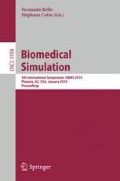Abstract
The segmentation of bones and bone fragments in clinical computed tomography datasets is an important first step in order to carry out computer-based surgical planning using patient-specific anatomical models. While semi-automatic and automatic methods have been proposed for the intact pelvic bone, the segmentation of bone fragments in the fractured pelvic bone still is a challenge due to weak boundaries and the diversity of injury patterns. We propose a semi-automatic multi-step segmentation method using bone and fracture gap enhancement filtering and a graph cut based bone fragment separation approach. The key contribution is a technique for automated detection of incorrect bone fragment separation in the case of incomplete pelvic fractures based on fracture gap planes detected in Hessian filtered images. Moreover, we propose a new sheetness measure based on a modified Hessian matrix. Our system is capable of segmenting fragments of complex hip fractures with only minimal user interaction.
Access this chapter
Tax calculation will be finalised at checkout
Purchases are for personal use only
Preview
Unable to display preview. Download preview PDF.
References
Dakin, G.J., et al.: Acetabular fracture patterns: associations with motor vehicle crash information. J. Trauma 47(6), 1063–1071 (1999)
Vanderschot, P.: Treatment options of pelvic and acetabular fractures in patients with osteoporotic bone. Injury 38(4), 497–508 (2007)
Citak, M., et al.: Virtual 3D planning of acetabular fracture reduction. J. Orthop. Res. 26(4), 547–552 (2008)
Cimerman, M., Kristan, A.: Preoperative planning in pelvic and acetabular surgery: the value of advanced computerised planning modules. Injury 38(4), 442–449 (2007)
anonymous
Kang, Y., Engelke, K., Kalender, W.A.: A new accurate and precise 3-D segmentation method for skeletal structures in volumetric CT data. IEEE Trans. Med. Imaging 22(5), 586–598 (2003)
Zoroofi, R.A., et al.: Automated segmentation of acetabulum and femoral head from 3-D CT images. IEEE Trans. Inf. Technol. Biomed. 7(4), 329–343 (2003)
Lamecker, H., et al.: A 3D statistical shape model of the pelvic bone for segmentation. In: Medical Imaging 2004: Image Processing, Pts 1-3, vol. 5370, pp. 1341–1351 (2004)
Pettersson, J., et al.: Volume Morphing for Segmentation of Bone from 3D Data. In: Proceedings of the SSBA Symposium on Image Analysis (2005)
Letournel, E.: Acetabulum fractures: classification and management. Clin. Orthop. Relat. Res. (151), 81–106 (1980)
Wei, W., Ronald, C.: Image segmentation via brittle fracture mechanics. In: International Conference on Image Processing, 2004. ICIP (2004)
Descoteaux, M., et al.: Bone enhancement filtering: application to sinus bone segmentation and simulation of pituitary surgery. Comput. Aided Surg. 11(5), 247–255 (2006)
Beare, R.: Optimization of connected component labelling. The Insight Journal (2006)
Greig, D.M., Porteous, B.T., Seheult, A.H.: Exact maximum a posteriori estimation for binary images. Journal of the Royal Statistical Society. Series B, 271–279 (1989)
Boykov, Y., Jolly, M.-P.: Interactive Organ Segmentation Using Graph Cuts. In: Delp, S.L., DiGoia, A.M., Jaramaz, B. (eds.) MICCAI 2000. LNCS, vol. 1935, pp. 276–286. Springer, Heidelberg (2000)
Schnabel, R., Wahl, R., Klein, R.: Efficient RANSAC for Point-Cloud Shape Detection. Computer Graphics Forum 26(2), 214–226 (2007)
Bookstein, F.L.: Principal warps: thin-plate splines and the decomposition of deformations. IEEE Transactions on Pattern Analysis and Machine Intelligence 11(6), 567–585 (1989)
Author information
Authors and Affiliations
Editor information
Editors and Affiliations
Rights and permissions
Copyright information
© 2010 Springer-Verlag Berlin Heidelberg
About this paper
Cite this paper
Fornaro, J., Székely, G., Harders, M. (2010). Semi-automatic Segmentation of Fractured Pelvic Bones for Surgical Planning. In: Bello, F., Cotin, S. (eds) Biomedical Simulation. ISBMS 2010. Lecture Notes in Computer Science, vol 5958. Springer, Berlin, Heidelberg. https://doi.org/10.1007/978-3-642-11615-5_9
Download citation
DOI: https://doi.org/10.1007/978-3-642-11615-5_9
Publisher Name: Springer, Berlin, Heidelberg
Print ISBN: 978-3-642-11614-8
Online ISBN: 978-3-642-11615-5
eBook Packages: Computer ScienceComputer Science (R0)

